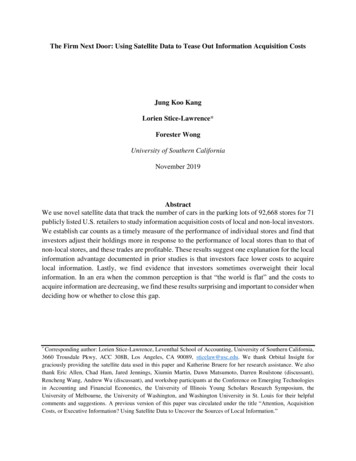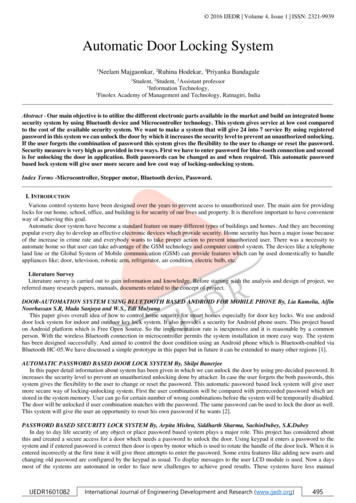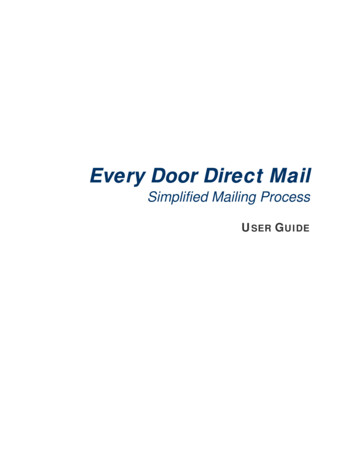
Transcription
The Firm Next Door: Using Satellite Data to Tease Out Information Acquisition CostsJung Koo KangLorien Stice-Lawrence*Forester WongUniversity of Southern CaliforniaNovember 2019AbstractWe use novel satellite data that track the number of cars in the parking lots of 92,668 stores for 71publicly listed U.S. retailers to study information acquisition costs of local and non-local investors.We establish car counts as a timely measure of the performance of individual stores and find thatinvestors adjust their holdings more in response to the performance of local stores than to that ofnon-local stores, and these trades are profitable. These results suggest one explanation for the localinformation advantage documented in prior studies is that investors face lower costs to acquirelocal information. Lastly, we find evidence that investors sometimes overweight their localinformation. In an era when the common perception is that “the world is flat” and the costs toacquire information are decreasing, we find these results surprising and important to consider whendeciding how or whether to close this gap.*Corresponding author: Lorien Stice-Lawrence, Leventhal School of Accounting, University of Southern California,3660 Trousdale Pkwy, ACC 308B, Los Angeles, CA 90089, sticelaw@usc.edu. We thank Orbital Insight forgraciously providing the satellite data used in this paper and Katherine Bruere for her research assistance. We alsothank Eric Allen, Chad Ham, Jared Jennings, Xiumin Martin, Dawn Matsumoto, Darren Roulstone (discussant),Rencheng Wang, Andrew Wu (discussant), and workshop participants at the Conference on Emerging Technologiesin Accounting and Financial Economics, the University of Illinois Young Scholars Research Symposium, theUniversity of Melbourne, the University of Washington, and Washington University in St. Louis for their helpfulcomments and suggestions. A previous version of this paper was circulated under the title “Attention, AcquisitionCosts, or Executive Information? Using Satellite Data to Uncover the Sources of Local Information.”0
I.IntroductionA large stream of literature has documented that local investors tend to have betterinformation about local firms than do non-local investors (see, for example, Bernile et al. 2015;Coval and Moskowitz 2001; Feng and Seasholes 2004). Underlying these prior findings is thebelief that local investors face lower costs to acquire local information. However, there has beenlittle to no evidence on whether local and non-local investors face different acquisition costs andif this contributes to local information advantage. We use novel satellite data that track theperformance of individual stores to document that local investors do face lower informationacquisition costs, which constitute a major driver of local information advantage.In this paper we explore one potential source of local information, which we refer to as theAcquisition Cost Channel of local information advantage. Local investors may face lower costs toacquire local information because of factors such as geographic proximity, social ties to nonexecutive firm employees, and local institutional knowledge. To investigate this channel, weexamine a sample of 92,668 stores of 71 publicly listed U.S. retailers during the years 2009 to2015. We use the number of cars in store parking lots as a timely measure of store-levelperformance and validate it by showing that average store-level car counts predict firm-levelquarterly changes in sales, changes in income, abnormal earnings announcement returns, andabnormal returns over the three months following the earnings announcement.Further, we define an investor as being local to an individual store if he or she is locatedwithin 100 miles and in the same state as that store.1 Because a firm may have stores in manyregions, investors may be local to some of a retailer’s stores and non-local to others. If investorsface lower costs to acquire information about local stores than non-local stores, they should1We present our main results for local variables based on several different definitions of proximity to ensure thatinferences are not sensitive to the specific definition that we choose.1
respond to different information sets depending on which stores are local to them. We provideevidence that this is the case by showing that investors adjust their stock holdings in response tothe car counts of stores that they are local to, but not to the concurrent performance of the overallfirm, suggesting that investors have real-time access only to information about their local stores.Further, we provide evidence that trades based on these local car counts are profitable, withannualized abnormal returns of roughly 2%. We interpret this as evidence that investors face lowercosts to access information about stores that are geographically close, and that this is one sourceof the local information advantage documented in prior research.We rule out alternative explanations for our observed results by showing the incrementalresponse to local store information is unlikely to be driven by information obtained directly fromfirm executives. Such information would relate to the entire firm and would be most available toinvestors located near the firm’s headquarters; however, we find no evidence that this is the case.Our results are also unlikely to be caused by investors choosing to collect information only aboutfirms that are local to them because of familiarity; there is no increase in investors’ response tolocal car counts when they are local to more of a firm’s stores, which would be expected to increasethe firm’s salience. In sum, our results are consistent with investors having less costly access tolocal information, and this finding does not appear to be driven by information obtained directlyfrom firm executives or through greater attention to local firms, although these alternative sourcesof local information may be at play in other settings or for other types of information.We conduct a series of cross-sectional tests which provide insight into the informationgathering process and further support the existence of the Acquisition Cost Channel of localinformation. First, we find that the incremental response to local information is largest for nonindexer investors (Bushee 2001), whose trades we expect to be most responsive to firm2
information. Second, we show that the response to local information is strongest for investorslocated in states with a low online presence, consistent with a greater local information gap inregions where it is more difficult to acquire firm information from a distance. Similarly, the localinformation gap is greater in regions which experience less cross-state migration, consistent withacquisition costs for locals being especially low in regions with tightly knit social networks.Lastly, we find evidence that investors sometimes overweight their local information.Although store-level car counts are less predictive of firm outcomes and returns when theirvariance is high, investors fail to discount their local information in these settings and as a resultmake less profitable trades.These results are important for several reasons. First, while a few papers have providedevidence consistent with an information advantage of local investors (Baik et al. 2010; Bernile etal. 2015; Coval and Moskowitz 2001), ours is the first to directly measure one type of localinformation and tie it to investors’ trades in order to explore a possible driver of this advantage.This is also the first study that measures whether a firm is considered local to an investor moregranularly and documents that investors have greater access to local relative to non-localinformation within a given firm. Further, our paper contributes to the literature on home bias(French and Poterba 1991) and local bias (Coval and Moskowitz 1999) showing that investorshold a disproportionate number of assets from their home country or state. Our study suggests thatpart of this local bias is attributable to investors responding to highly localized information.Second, while the prevailing notion is that local information advantage is disappearing(Bernile et al. 2018), we demonstrate that investors have significantly lower costs to access localinformation. These results are especially surprising because we focus exclusively on institutionalinvestors; these investors are relatively large and sophisticated, with many more resources at their3
disposal than individual retail investors. Given that we find evidence of significant acquisitioncosts of non-local information in this setting, we expect the costs are even greater for individuals.In sum, we provide evidence that geographic information frictions still play a role even in thishigh-speed technological era, and add our voice to that of Blankespoor et al. (2019a) that the costsof acquiring and processing information are far from immaterial.Third, our study adds to the emerging field which uses big data to examine fundamentalquestions (Froot et al. 2017), as well as research examining the impact of big data on firms andinvestors (Zhu 2019). Our study is especially timely given that granular and almost instantaneouslyavailable data like the data we use (which is available to investors the next day) is becoming moreand more prevalent, and investors routinely supplement the formal financial statements with lesstraditional information sources (Goldman Sachs 2016)Fourth, this study contributes to the literature on information frictions. While a number ofstudies have documented the consequences of investors’ information frictions (e.g., Ayers et al.2011; Hirshleifer et al. 2009), empirical evidence on the sources of these frictions is relativelyscarce. A notable exception is Blankespoor et al. (2019b) which shows that retail investors havedifficulty incorporating relevant earnings numbers into their trades because of the costs ofprocessing information they have already acquired. Our study complements Blankespoor et al.(2019b) by exploring the role of acquisition costs while holding the investors and the type ofinformation (and therefore processing costs) constant.Lastly and most importantly, by identifying one source of the local information gap, ourstudy provides evidence that can be used in the policy discussion about how or whether this gapshould be narrowed. While a key role of the SEC is ensuring that all investors have equal accessto firm information, the SEC has clarified that information differences among investors arising4
from “skill,” “diligence,” or “hard work” (SEC 2000) are a normal and desirable aspect ofsecurities markets. To the extent that differential acquisition costs enable local investors to accessinformation that is not a result of their own effort, the SEC might believe there is a role forincreased disclosure. On the other hand, the SEC may view information asymmetry which arisesas a function of geographic location as an inescapable part of the capital markets and deemintervention unnecessary, especially to the extent that this disparity could only be eliminatedthrough costly disclosure. The SEC may also rely on ongoing decreases in the costs of informationacquisition and sharing made possible by advances in technology to further narrow this gapwithout the need for regulatory interference. Indeed, investors have begun to address thisinformation disparity by acquiring the very data that we use in this study. However, VanNieuwerburgh and Veldkamp (2009) predict even small differences in initial informationendowments can lead to large information asymmetries between local and non-local investors,indicating any differences in local and non-local information acquisition costs may be relevant toregulators. We see our evidence as the necessary first step to begin that discussion.Our study is subject to two important caveats. First, we cannot observe investors’information sets and infer their information by observing their trades. Second, our results mayhave limited generalizability because we examine only institutional investors of retail firms andonly capture local information that is correlated with car counts. Local information advantage maybe different for non-retail firms, for other investors, or for other types of local information. Wenote that, while our sample of firms is small, our set of investors represents a substantial portion(approximately ¾) of the institutional investor population. While we acknowledge these caveats,we believe that our study is able to provide important insights with respect to local information.5
II.Related Literature and HypothesesA number of studies have documented evidence consistent with local investors havingaccess to additional information (Bae et al. 2008; Baik et al. 2010; Bernile et al. 2015; Chi andShanthikumar 2016; Coval and Moskowitz 2001); however, these studies have largely beenagnostic as to the source of this information advantage. We predict that one source is that investorsface lower costs to acquire local information and refer to this as the Acquisition Cost Channel oflocal information advantage.Investors who are local to a firm may face lower costs to acquire information about nearbyfirm activities because of their geographic proximity. For example, local investors may directlyobserve business operations of the firm such as construction and shipping operations; theirknowledge of local economic conditions, laws, and institutions may help them predict and interpretinformation about local performance; local media outlets or analysts may disproportionately gatherand disseminate information about local business activities (Miller and Shanthikumar 2015); or abroad network of non-executive-level social ties may expose them to a “mosaic” of informationsuch as the general busyness of local operations and hiring activities. Non-local investors wishingto obtain the same information would need to incur greater costs by purchasing businessintelligence, poring over public reports, or traveling to the site.Although the prior literature has proposed this potential mechanism for local informationadvantage, these conjectures have never been thoroughly tested. For example, Ellis, Madureira,and Underwood (2017) find that mutual funds invest more in firms that are easier to travel to andthat these investments are more profitable, potentially indicating that lower acquisition costscontribute to local information advantage. However, their results may also stem from the abilityof institutional investors to monitor firms, which could directly contribute to performance, or6
greater access by investors to information from firm executives. Next, Engelberg and Parsons(2011) find that investors are more likely to trade a firm’s stock if it is covered by a localnewspaper, consistent with lower costs for local newspapers to unearth value-relevant information(Miller and Shanthikumar 2015); however, this could also be driven by investors myopicallyfocusing on firms covered in the local press. In sum, the academic literature on the sources of localadvantage in general, and acquisition costs in particular, is incomplete.We identify a setting that is particularly well suited to measure differential local acquisitioncosts, and make two hypotheses to identify whether the Acquisition Cost Channel contributes tolocal information advantage. In order to do so, we use the number of cars in retail store parkinglots as a location-specific proxy of firm performance and define an investor as Local to a givenstore if they are located near that store. Thus, an investor may be local to some stores within a firmand non-local to others. Figure 2 panels A and B provide a graphical depiction of this definition.We first predict that if local investors benefit from lower acquisition costs, they should beable to acquire more information about the stores that they are local to (Local) relative to otherstores within the same firm. As a result, investors’ information sets will disproportionately containsignals about their local stores, and their stock holdings will change in response to the performanceof these stores even after controlling for their response to overall firm performance. TheAcquisition Cost Channel hypothesis is thus:H1: Changes in investors’ stock holdings have a positive relation with changes inthe car counts of local stores that is incremental to their response to car counts ofthe firm overall.Second, if the information that investors obtain about local stores contributes to the localinformation advantage documented in prior research (Coval and Moskowitz 2001), then trades7
based on this information should be profitable. Otherwise this channel is not an explanation forlocal information advantage. This could be the case if investors overweight information obtainedfrom local sources (Cheng and Eshleman 2014), if the amount of incremental useful informationavailable from local sources is negligibly small, or if they simply do not understand how to uselocal information once they have acquired it (Blankespoor et al. 2019b). We predict:H2: Trades based on local information are profitable.Lastly, although we predict that lower costs to acquire local information benefit investorsby helping them to make profitable trades, we expect that investors may sometimes overweightthese local signals. Prior research has found evidence that local investors sometimes tradesuboptimally for non-information-driven reasons (Hochberg and Rauh 2013; Hornuf and Schmidt2017; Seasholes and Zhu 2010), and research such as Chen and Jiang (2006) has shown that evensophisticated market participants sometimes overweight information signals. In our setting,overweighting an information signal would mean placing a higher weight on that signal whenmaking trading decisions than would be optimal to maximize future returns. Thus while localinformation may be a profitable source of information, if investors disproportionately weight localsignals, this might decrease the profitability of their trades. This would be especially easy to detectwhen local store performance is less representative of overall firm performance (and thus lessuseful for predicting future returns), because investors who appropriately weight information inthis setting should decrease their reliance on local information, but investors who overweight localinformation would not adequately discount it (Cheng and Eshleman 2014). Thus, if investorsoverweight local information we predict:H3a: Investors fail to adequately discount local information in their tradingdecisions when it is less representative of overall firm performance.8
H3b: Trades based on local information are less profitable when local informationis less representative of overall firm performance.For each of the three hypotheses listed above, we expect that testing them using data oninstitutional investors provides a particularly low power setting and high empirical hurdle. First,because institutional investors are relatively large with significant investments in informationgathering and analysis, it is possible that the incremental costs of gathering location-specificinformation are comparatively small, especially because they may have satellite offices that exposethem to geography-specific information for multiple locations. In addition, because institutionalinvestors are sophisticated and trading decisions are often the combined effort of multipleindividuals working together, these investors may be less prone to overweight local information.Ultimately, it is an empirical question whether local information acquisition costs or overweightingaffect the information sets of institutional investors.III.Empirical Setting and Variable DefinitionsIn this paper, we use data from six main sources to measure local information from March2009 to March 2015. First, we use satellite data from Orbital Insight. Next, we use 13F data
The Firm Next Door: Using Satellite Data to Tease Out Information Acquisition Costs Jung Koo Kang Lorien Stice-Lawrence* Forester Wong University of Southern California November 2019 Abstract We use novel satellite data that track the n











